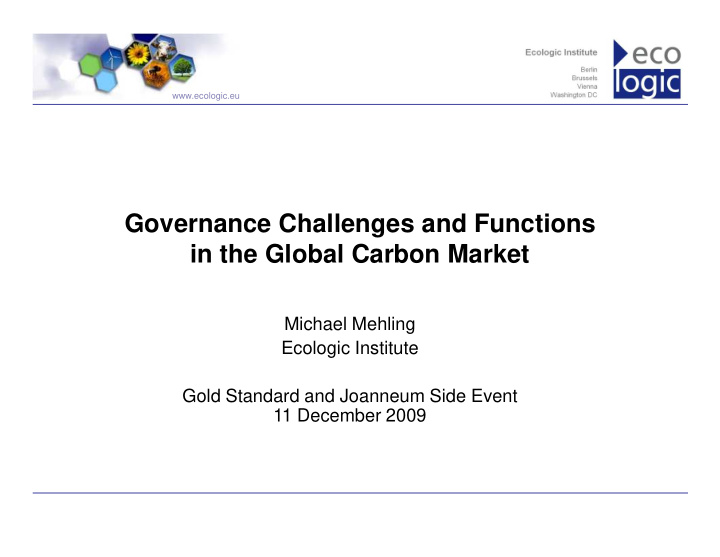



www.ecologic.eu Governance Challenges and Functions in the Global Carbon Market Michael Mehling Ecologic Institute Gold Standard and Joanneum Side Event 11 December 2009
www.ecologic.eu Jos Delbeke, Deputy Director General, European Commission “We are building the global carbon market from the bottom-up.” ICAP Global Carbon Market Forum, 19-20 May 2008, Brussels Robert N. Stavins, Harvard University “Linkage may become the de jure or de facto post-2012 international policy” 7th Annual Workshop on Greenhouse Gas Emission Trading, 9 October 2007, Paris 2
www.ecologic.eu Linking: A European Perspective European Commission Towards a Comprehensive Climate Change Agreement in Copenhagen, COM(2009)39 final of 28 January 2009: “Domestic carbon markets can and “Domestic carbon markets can and should be linked to build an effective global market … a robust OECD-wide carbon market by 2015, to be further extended to economically more advanced developing countries by 2020.” 3
www.ecologic.eu Mark Lazarowicz, Special Representative on Carbon Trading, United Kingdom “A dual-level system of global carbon trading could reduce the costs of emissions reductions by up to 70%. These efficiencies could potentially allow the world to reduce emissions by an additional 40-50% at the same cost while providing substantial financial flows to the developing world to support the move to a low carbon economy with sustainable growth.” 4
www.ecologic.eu Pathways to a Global Carbon Market Source: Lazarowicz, 2009 5
www.ecologic.eu http://www.decc.gov.uk/en/content/cms/what_we_do/change_energy/tackling_clima/emissions/emissions.aspx 6
www.ecologic.eu But Market Integration Can also Pose Risks … Potential Drawbacks of Linking “Contagious” design features of each system will be perpetuated across linked markets, risking an increase of overall emissions Systems with rising prices may see increased compliance costs and higher energy prices: competitiveness and distributional concerns Depending on the mechanism used to link, states may cede sovereignty to effect changes on certain design features of their 7
www.ecologic.eu The Need for Compatibility – EU Mandate Post-2012 Article 25 (1) of the Revised EU ETS Directive “Agreements may be made to provide for the recognition of allowances between the Community scheme and compatible mandatory between the Community scheme and compatible mandatory greenhouse gas emissions trading systems with absolute emissions caps established in any other country or in sub-federal or regional entities.” 8
www.ecologic.eu Elements of Compatibility – A Barrier Analysis Compatibility of linked systems is essential price caps, borrowing, absolute/relative caps, ex-post adjustments, continuity Compatibility of linked systems is desirable enforcement, stringency, banking, commitment periods, offset crediting enforcement, stringency, banking, commitment periods, offset crediting Differences between systems are possible compliance periods, monitoring and verification standards, leakage control, allocation methods, new entrants and closures, sectoral coverage, registries (Tuerk/Mehling/Flachsland/Sterk, 2009) 9
www.ecologic.eu Elements of Compatibility – A Barrier Analysis Design Feature Mutual Compatibility Scope and timeline Covered sectors desirable Commitment periods desirable Continuity of scheme essential New entrants and closures optional Ex-post adjustments essential Tradable units Tradable units Fungibility of units Fungibility of units desirable desirable Reduction obligation (‘Cap’) Absolute v relative essential Environmental stringency desirable Allocation Allocation method optional Banking Possibility of banking units desirable Cost containment Price ceilings essential Borrowing essential Offset crediting desirable Competition and leakage Leakage control mechanisms optional Governance Monitoring and verification optional enforcement rules desirable registries optional Source: Tuerk et al., 2009 10
www.ecologic.eu Ensuring Compatibility over Time Domestic or regional systems can be changed unilaterally Incentive dynamics change under a link: systems can become net sellers by reducing their environmental stringency Mechanisms to sustain compatibility a process for agreeing on or notifying revisions to the system mechanisms to ensure environmental effectiveness of each system a procedure for terminating or withdrawing from the link (Source: Mehling/Haites, 2009) 11
www.ecologic.eu Thinking Ahead: Pathways to a Global Carbon Market 1 st Phase: Emergence of GHG emissions trading at the national/subnational level; early markets are immature, limited in market size, with low liquidity and high volatility 2 nd Phase: Some national systems converge, regional systems emerge; generally larger market size, greater maturity, rise of a professional services sector; yet globally, markets still fragmented 3 rd Phase: Cooperation across systems emerges, informal exchange on information and practices; unilateral and indirect linking widespread 4 th Phase: Formal bi- and multilateral linking expands, intensfied cooperation to sustain compatibility of converging markets 5 th Phase: Global carbon market with broad multilateral participation 12
www.ecologic.eu 13
www.ecologic.eu Potential Governance Challenges Source: Mehling, 2009a 14
www.ecologic.eu Addressing Governance Challenges 15
www.ecologic.eu Addressing Governance Needs Further Research Questions Do existing institutions meet governance needs, and to what extent? If new institutional arrangements are needed: - what degree of legal formality and centralization is needed? - can other institutions serve as models for carbon market governance? - to what extent is the domestic governance debate relevant? Climate Strategies Project (2010-2011) : Linking in the Context of the Post-2012 Climate Architecture 16
www.ecologic.eu References Lazarowicz, Mark (2009): Global Carbon Trading: a Framework for Reducing Emissions, Office of Climate Change, London, U.K., available at: http://www.decc.gov.uk/en/content/cms/what_we_do/change_energy/tackling_clima/emissions/emissio ns.aspx. Mehling, Michael (2009a): Global Carbon Market Institutions: An Assessment of Governance Challenges and Functions in the Carbon Market , Background Paper prepared for the Office of Climate Challenges and Functions in the Carbon Market , Background Paper prepared for the Office of Climate Change, London, U.K., available at: http://www.decc.gov.uk/en/content/cms/what_we_do/change_energy/tackling_clima/emissions/emissio ns.aspx. Mehling, Michael, and Erik Haites (2009): “Mechanisms for Linking Emissions Trading Schemes.” 9 Climate Policy : 169-184. Tuerk, Andreas, Michael Mehling, Christian Flachsland, and Wolfgang Sterk (2009): “Linking Carbon Markets: Concepts, Case Studies and Pathways.” 9 Climate Policy (2009): 341-357. 17
www.ecologic.eu Thank You! Ecologic Institute, 1630 Connecticut Ave. NW, Suite 300 Washington, DC 20009 Washington, DC 20009 � � +1-202-518-2060, � � � � � + 1-202-387-4823 � michael.mehling@ecologic-institute.us www.ecologic-institute.us 18
Recommend
More recommend